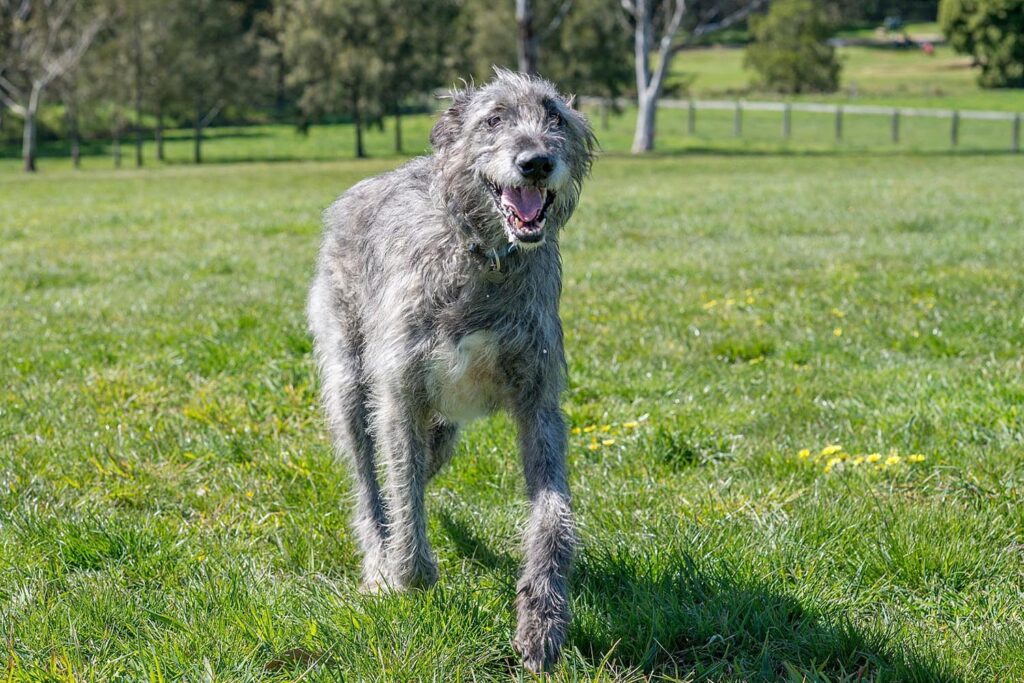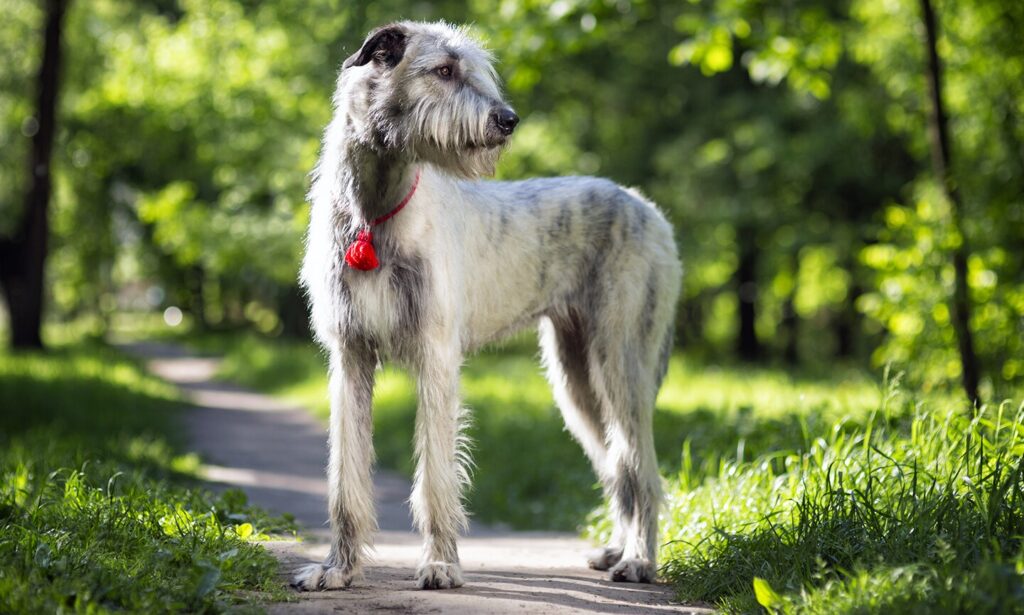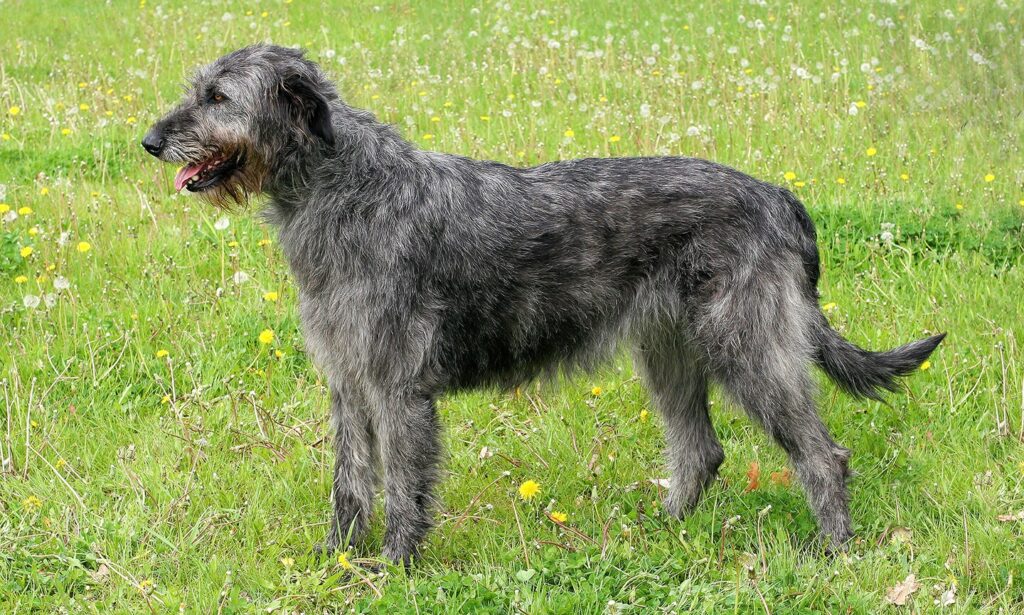Introduction to Irish Wolfhounds: Unveiling the Gentle Giants
The Irish Wolfhound, a breed that effortlessly combines majesty and gentleness, stands as a towering figure in the canine world. Often referred to as gentle giants, these dogs carry a rich history, intertwined with the folklore and traditions of Ireland. This introduction aims to peel back the layers of mystery surrounding this noble breed, offering insights into their unique characteristics and why they hold a special place in the hearts of dog enthusiasts worldwide.
Historical Legacy
The Irish Wolfhound’s lineage traces back to antiquity, with their roots deeply embedded in the rich tapestry of Irish history. Originally bred for hunting wolves and guarding homesteads, these hounds were esteemed by both nobility and warriors for their bravery, strength, and loyalty. Their historical significance is not just limited to Ireland; they were so revered that tales of their valor and size traveled across seas, making them a symbol of nobility and honor in many cultures.
Physical Majesty
Standing at an impressive height, Irish Wolfhounds are one of the tallest dog breeds in the world. Males can reach up to 32 inches at the shoulder, with females not far behind. Despite their imposing size, they move with a surprising grace and elegance. Their rough, wiry coat, which can come in various colors like gray, brindle, and red, adds to their distinguished appearance. This physical grandeur, however, is not just for show; it is a testament to their historical role as capable hunters and formidable protectors.
Temperament: The Gentle Soul
Contrary to what their size might suggest, Irish Wolfhounds are known for their gentle and friendly demeanor. They exhibit a calm and patient nature, making them excellent companions, especially in families. Their interaction with children and other pets is often marked by a tender, nurturing attitude, reflecting their well-rounded personality. This gentle nature, however, does not detract from their alertness and courage, traits that made them excellent guard dogs in their earlier roles.
A Breed Apart
The Irish Wolfhound is not just a pet; it’s a companion that brings a piece of history into your home. Their unique blend of strength, elegance, and gentleness sets them apart from other breeds. As we delve deeper into understanding these magnificent creatures, it becomes evident that owning an Irish Wolfhound is not just about providing care; it’s about embracing a legacy.
Training an Irish Wolfhound Puppy: Laying the Foundation for a Gentle Giant
Training an Irish Wolfhound puppy is a journey that requires patience, understanding, and a deep appreciation for the breed’s unique characteristics. These early stages of training are crucial in shaping a well-mannered, sociable, and obedient adult dog. This section delves into the essentials of puppy training, emphasizing the importance of positive reinforcement and consistent guidance.
Early Socialization: The Key to a Well-Rounded Dog
Socialization is the cornerstone of puppy training, especially for a breed as large and imposing as the Irish Wolfhound. Exposing your puppy to a variety of experiences, people, and other animals during their formative weeks is vital. This exposure helps them develop into well-adjusted adults, reducing the likelihood of fear or aggression towards unfamiliar situations. Puppy classes can be an excellent way to introduce your Wolfhound to other dogs and people in a controlled environment.
House Training: Establishing Routine and Consistency
House training an Irish Wolfhound puppy requires consistency, patience, and a set routine. Due to their size, even a young Wolfhound can be a handful if not properly trained. Establish a regular schedule for feeding and bathroom breaks, and stick to it. Use positive reinforcement when your puppy does their business outside, and avoid punishment for accidents indoors. Remember, patience is key – it takes time for puppies to develop bladder control.
Basic Obedience: Building a Foundation of Respect
Teaching basic obedience commands like ‘sit’, ‘stay’, ‘come’, and ‘heel’ is essential. Start with short training sessions, keeping them fun and rewarding. Irish Wolfhounds are intelligent but can be independent, so it’s important to make training engaging. Use treats, praise, and play as rewards. Consistency in command usage and routine is crucial – everyone in the household should use the same commands and reward system.
The Role of Positive Reinforcement
Positive reinforcement is particularly effective with Irish Wolfhounds. They respond well to rewards and praise, and harsh methods can lead to stubbornness or fearfulness. Focus on rewarding good behavior rather than punishing bad behavior. This approach not only strengthens the bond between you and your puppy but also fosters a love for learning and obedience.
Conclusion
Training an Irish Wolfhound puppy is an enriching experience that sets the stage for a lifetime of companionship. With consistent, positive training methods, you can nurture your gentle giant into a well-behaved, sociable, and loving member of your family.
Training an Adult Irish Wolfhound: Fostering Obedience and Understanding
Transitioning from puppyhood to adulthood, Irish Wolfhounds require continued training to maintain their gentle demeanor and ensure they are well-adjusted members of the family. Training an adult Irish Wolfhound is not just about reinforcing basic commands but also about understanding and respecting their unique temperament and physical needs.
Embracing the Breed’s Independence
Irish Wolfhounds are known for their independent nature, a trait that can be both a challenge and a strength in training. It’s important to balance firm guidance with respect for their autonomy. Training should be a collaborative effort, where the dog feels involved and engaged rather than forced. This approach helps in building trust and a stronger bond between the dog and its owner.
Advanced Obedience Training
While basic commands are essential, advancing to more complex training can be beneficial for both the dog and the owner. Training in areas such as agility, tracking, or even therapy work can provide mental stimulation and a sense of purpose for these intelligent dogs. However, due to their size and build, it’s crucial to ensure that any physical activities are suitable for their capabilities, avoiding any strain on their joints.
Consistency and Routine
As with any dog, but especially with a breed as large as the Irish Wolfhound, consistency in commands and routine is key. Consistent training sessions, regular exercise, and a stable routine help in reinforcing good behavior. It’s also important for all family members to be on the same page with training techniques and commands to avoid confusion and ensure a cohesive training environment.
Dealing with Stubbornness
At times, Irish Wolfhounds can exhibit stubbornness, a trait that requires patience and understanding from the owner. In such instances, it’s important to remain calm and assertive, reinforcing commands without resorting to harsh discipline. Finding what motivates your dog, be it treats, praise, or play, can be effective in encouraging cooperation.
Conclusion
Training an adult Irish Wolfhound is a continuous process that requires patience, consistency, and an understanding of the breed’s unique characteristics. With the right approach, these gentle giants can be trained to be obedient, well-mannered, and a joy to have around.
Common Training Challenges and Solutions for Irish Wolfhounds
Training an Irish Wolfhound, like any breed, comes with its set of challenges. Understanding these challenges and knowing how to address them effectively can make the training process smoother and more enjoyable for both the dog and the owner. This section explores common training issues specific to Irish Wolfhounds and offers practical solutions.
Challenge 1: Distraction and Prey Drive
Irish Wolfhounds, with their hunting heritage, can be easily distracted, especially by small animals or moving objects. This strong prey drive can make it difficult to maintain their attention during training sessions.
Solution: To combat distraction, training should start in a quiet, controlled environment. Gradually introduce distractions in a controlled manner, rewarding the dog for maintaining focus. Consistent recall training is crucial, especially in off-leash scenarios.
Challenge 2: Stubbornness and Independence
The breed’s independent nature can sometimes be perceived as stubbornness. This can manifest as a reluctance to follow commands or a desire to do things their own way.
Solution: Patience and consistency are key. Use positive reinforcement to encourage desired behaviors. Find what motivates your dog – treats, praise, or toys – and use it to gain their cooperation. Avoid turning training into a power struggle.
Challenge 3: Sensitivity to Harsh Training Methods
Despite their size, Irish Wolfhounds are sensitive dogs. They do not respond well to harsh training methods and can become withdrawn or unresponsive.
Solution: Always use positive, reward-based training methods. Harsh corrections should be avoided. Instead, focus on building trust and a positive relationship with your dog.
Challenge 4: Size-Related Training Issues
Their large size can make certain training aspects, like leash training, more challenging, especially if the dog decides to pull or not cooperate.
Solution: Start leash training early and use appropriate equipment like a well-fitted harness. Teach them to walk without pulling using positive reinforcement. Remember, physical exercise is important but should be appropriate for their size to avoid joint issues.
Challenge 5: Boredom and Lack of Mental Stimulation
Irish Wolfhounds are intelligent and can become bored with repetitive training.
Solution: Keep training sessions short, fun, and varied. Introduce new commands and tricks to keep them mentally stimulated. Consider activities like scent work or agility that can provide both physical and mental exercise.
Advanced Training and Activities for Irish Wolfhounds
As Irish Wolfhounds mature, their training can be elevated to more advanced levels, incorporating activities that not only keep them physically fit but also mentally stimulated. This section explores various advanced training techniques and activities that are well-suited for Irish Wolfhounds, ensuring they lead a balanced and fulfilling life.
Advanced Obedience Training
Building upon basic commands, advanced obedience training can include more complex commands and behaviors. This might involve mastering commands like ‘heel’ with distractions, ‘stay’ for extended periods, or responding to hand signals. Such training enhances their focus, discipline, and responsiveness.
Agility Training
Despite their size, Irish Wolfhounds can enjoy and excel in agility training. This activity is excellent for physical exercise, mental stimulation, and strengthening the bond between the dog and the owner. However, it’s crucial to ensure that the agility training is adapted to their size and physical capabilities, avoiding high jumps or tight turns that could strain their large bodies.
Therapy and Service Work
Irish Wolfhounds, known for their gentle and calm demeanor, can be excellent candidates for therapy or service work. Training for these roles involves teaching them to be comfortable and well-behaved in various public settings, gently interacting with people, and providing comfort or assistance. This work can be incredibly rewarding for both the dog and the people they help.
Scent Work and Tracking
Leveraging their hunting heritage, scent work and tracking can be a fascinating activity for Irish Wolfhounds. This type of training stimulates their natural instincts and provides a healthy outlet for their energy. It involves teaching them to identify and follow a specific scent, which can be both a fun and mentally engaging exercise.
Participating in Dog Sports
Dog sports like lure coursing or rally obedience can be suitable for Irish Wolfhounds, offering them a chance to engage in physical activity while honing their training. These sports can cater to their natural instincts and abilities, providing a structured outlet for their energy and intelligence.
Tailoring Activities to Individual Dogs
It’s important to remember that each Irish Wolfhound is unique. What excites and motivates one dog might not work for another. Owners should observe their dog’s preferences and tailor activities to suit their individual temperament and physical capabilities.
Conclusion
Advanced training and activities not only keep Irish Wolfhounds physically fit but also mentally sharp. By engaging them in these activities, owners can ensure their gentle giants are well-rounded, happy, and healthy.
Training Tools and Aids for Irish Wolfhounds
Training an Irish Wolfhound is a unique experience, and having the right tools and aids can make a significant difference. This section focuses on the best training tools and aids for Irish Wolfhounds, ensuring that the training process is effective, safe, and enjoyable for both the dog and the owner.
Harnesses and Leashes
Given their size and strength, choosing the right harness and leash is crucial. A well-fitted harness can provide better control during walks and training sessions, especially for a large breed like the Irish Wolfhound. It distributes pressure evenly across the chest and back, reducing strain on the neck. A sturdy, long leash allows for controlled freedom, essential for training recall and obedience commands.
Training Collars
While traditional collars are common, it’s important to select one that is comfortable and safe for your Irish Wolfhound. Martingale collars can be a good option as they provide gentle control without the choking effect of standard choke collars. However, the use of any training collar should be guided by a professional to ensure it’s used correctly and humanely.
Clickers for Positive Reinforcement
Clicker training is an effective method for teaching new behaviors and reinforcing positive actions. The clicker’s sound serves as a clear and consistent signal that the dog has performed the desired behavior, followed by a reward. This tool is particularly useful for Irish Wolfhounds, as it helps capture their attention and focus during training sessions.
Treat Pouches and High-Value Treats
Having treats readily available is essential for positive reinforcement training. A treat pouch allows for easy access and quick reward delivery. High-value treats, which are particularly appealing to your dog, can be very effective in motivating them and reinforcing positive behaviors.
Interactive Toys and Puzzle Feeders
To keep their intelligent minds engaged, interactive toys and puzzle feeders are excellent. These tools not only provide mental stimulation but also can be used in training sessions to teach problem-solving skills and focus.
Training Mats and Beds
Training mats or beds can be used to teach ‘place’ or ‘stay’ commands. They provide a designated spot for the dog to relax and stay put, which is especially useful in managing a large breed like the Irish Wolfhound in various settings.
Conclusion
The right training tools and aids can significantly enhance the training experience for both the Irish Wolfhound and the owner. By selecting appropriate and breed-specific tools, training can become more effective, enjoyable, and rewarding. Remember, the goal is to foster a positive learning environment that respects the dog’s nature and strengthens the bond between pet and owner.
Conclusion
As we reach the end of our comprehensive exploration into training Irish Wolfhounds, it’s clear that this journey is as rewarding as it is challenging. These majestic dogs, with their rich history and gentle nature, offer a unique experience that goes beyond the basics of sit, stay, and heel. Training an Irish Wolfhound is about building a deep, respectful bond, one that honors their heritage and caters to their individual needs.
Understanding and Patience: The Heart of Training
The key to successfully training an Irish Wolfhound lies in understanding their temperament and being patient with their learning curve. Their independent nature requires a training approach that is both firm and gentle, blending discipline with affection. Remember, every moment spent in training is an opportunity to strengthen the bond between you and your Wolfhound.
The Importance of Early Socialization and Consistent Training
Early socialization and consistent training throughout their life are crucial in shaping a well-behaved and sociable Irish Wolfhound. These early experiences lay the foundation for their future behavior and interaction with the world around them. As they grow, continuing with advanced training and activities keeps their minds sharp and bodies healthy.
A Lifelong Commitment to Learning and Growth
Training an Irish Wolfhound is a lifelong commitment. As they transition from playful puppies to dignified adults, their training needs evolve. Embracing this journey with a willingness to learn and adapt is essential. Whether it’s mastering new commands, exploring dog sports, or simply enjoying a peaceful walk, every experience contributes to their well-being.
The Joy of Living with a Trained Irish Wolfhound
Living with a well-trained Irish Wolfhound is a joy and a privilege. These gentle giants bring a sense of calm and companionship that is unmatched. Their presence is a constant reminder of the beauty and grace of the canine world.
Final Thoughts
In conclusion, training an Irish Wolfhound is about more than obedience; it’s about understanding, respect, and mutual growth. It’s a journey that requires patience, consistency, and above all, love. As you embark on this journey with your Irish Wolfhound, cherish every moment, for it is these shared experiences that create an unbreakable bond and a lifetime of memories.
Frequently Asked Questions
How long does it take to train an Irish Wolfhound?
Training is an ongoing process, but basic obedience training can take a few months. Consistency and patience are key. Remember, each dog is different, and some may learn quicker than others.
Are Irish Wolfhounds easy to train?
Irish Wolfhounds are intelligent but can be independent, which can sometimes be mistaken for stubbornness. With the right approach, including positive reinforcement and consistency, they can be trained effectively.
How do I stop my Irish Wolfhound from pulling on the leash?
Start leash training early. Use a well-fitted harness and practice walking in a distraction-free environment. Reward them for walking calmly by your side. If pulling persists, consider seeking help from a professional trainer.
Can Irish Wolfhounds be trained for agility courses?
Yes, they can participate in agility training, but the courses should be adapted to their size and physical capabilities. Avoid high jumps or tight turns to prevent strain on their joints.
How do I socialize my Irish Wolfhound puppy?
Begin socialization early by exposing your puppy to different people, animals, environments, and sounds. Puppy classes can be beneficial. Always ensure that these experiences are positive and not overwhelming for your puppy.




